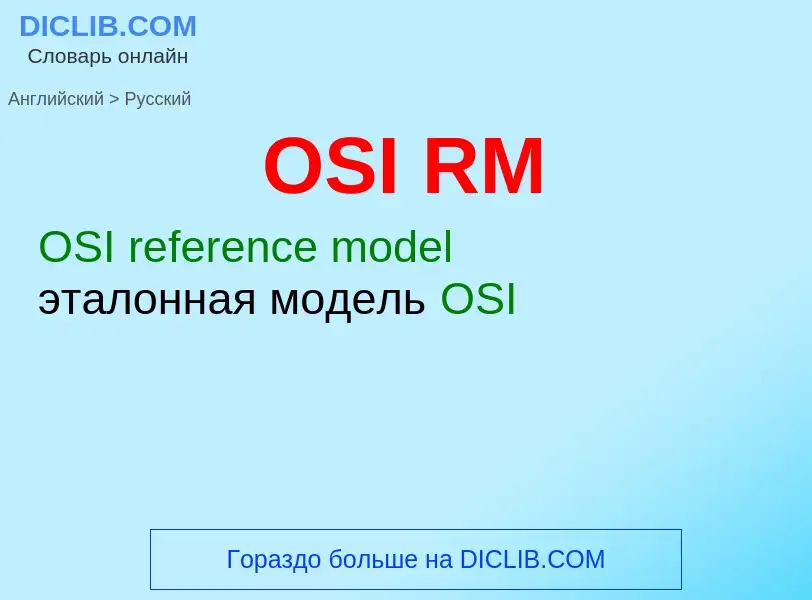Перевод и анализ слов искусственным интеллектом ChatGPT
На этой странице Вы можете получить подробный анализ слова или словосочетания, произведенный с помощью лучшей на сегодняшний день технологии искусственного интеллекта:
- как употребляется слово
- частота употребления
- используется оно чаще в устной или письменной речи
- варианты перевода слова
- примеры употребления (несколько фраз с переводом)
- этимология
OSI model - перевод на Английский
общая лексика
Open Systems Interconnection
взаимодействие открытых систем, эталонная модель OSI
семиуровневая модель протоколов передачи данных, утверждённая ISO в 1984 г., для обеспечения взаимодействия открытых систем. В модели OSI все сетевые функции разделены на уровни таким образом, что все вышележащие уровни пользуются услугами нижележащих через стандартизованные интерфейсы. Такая структура позволяет модифицировать любой из уровней, не затрагивая остальные. Уровни OSI снизу вверх: физический (physical layer), канальный (data link layer), сетевой (network layer), транспортный (transport layer), сеансовый (session layer), представления данных (presentation layer) и прикладной (application layer). Поскольку уровни с первого по третий управляют физической доставкой данных по сети, то их иногда называют уровнями среды передачи данных (media layers)
комитет OSI
международная организация под спонсорством ISO, занимающаяся разработкой международных стандартов в области передачи данных
сокращение
[oil well, shut-in] нефтяная скважина с закрытым устьем
Смотрите также
соединение (взаимосвязью открытых систем
нефтегазовая промышленность
модель долговечности
Википедия
The Open Systems Interconnection model (OSI model) is a conceptual model that 'provides a common basis for the coordination of [ISO] standards development for the purpose of systems interconnection'. In the OSI reference model, the communications between a computing system are split into seven different abstraction layers: Physical, Data Link, Network, Transport, Session, Presentation, and Application.
The model partitions the flow of data in a communication system into seven abstraction layers to describe networked communication from the physical implementation of transmitting bits across a communications medium to the highest-level representation of data of a distributed application. Each intermediate layer serves a class of functionality to the layer above it and is served by the layer below it. Classes of functionality are realized in all software development through all and any standardized communication protocols.
Each layer in the OSI model has its own well-defined functions, and the functions of each layer communicate and interact with the layers immediately above and below it, unless the layer does not have layers below or above.
The Internet protocol suite has a separate model, the layers of which are mentioned in RFC 1122 and RFC 1123. That model combines the physical and data link layers of the OSI model into a single link layer, and has a single application layer for all protocols above the transport layer, as opposed to the separate application, presentation and session layers of the OSI model.
In comparison, several networking models have sought to create an intellectual framework for clarifying networking concepts and activities, but none have been as successful as the OSI reference model in becoming the standard model for discussing, teaching, and learning for the networking procedures in the field of information technology. Additionally, the model allows transparent communication through equivalent exchange of protocol data units (PDUs) between two parties, through what is known as peer-to-peer networking (also known as peer-to-peer communication). As a result, the OSI reference model has not only become an important piece among professionals and non-professionals alike, but also in all networking between one or many parties, due in large part to its commonly accepted user-friendly framework.


![Inspiration]]'' (1915), the second non-pornographic American film containing nude scenes. Inspiration]]'' (1915), the second non-pornographic American film containing nude scenes.](https://commons.wikimedia.org/wiki/Special:FilePath/Audrey Munson as nude art model in movie Inspiration (1915).jpg?width=200)
![''Model writing postcards'' by [[Carl Larsson]] (1906) ''Model writing postcards'' by [[Carl Larsson]] (1906)](https://commons.wikimedia.org/wiki/Special:FilePath/Carl Larsson Model writing postcards 1906.jpg?width=200)
![''[[The Art of Painting]]'' by [[Johannes Vermeer]], c. 1666 ''[[The Art of Painting]]'' by [[Johannes Vermeer]], c. 1666](https://commons.wikimedia.org/wiki/Special:FilePath/Jan Vermeer - The Art of Painting - Google Art Project.jpg?width=200)
![Nude study by [[William Mortensen]] Nude study by [[William Mortensen]]](https://commons.wikimedia.org/wiki/Special:FilePath/KOPPITZ 0007.jpg?width=200)
![''Portrait d'Olga dans un fauteuil'', ([[Pablo Picasso]]'s wife [[Olga Khokhlova]] in an Armchair), {1917–1918} ''Portrait d'Olga dans un fauteuil'', ([[Pablo Picasso]]'s wife [[Olga Khokhlova]] in an Armchair), {1917–1918}](https://commons.wikimedia.org/wiki/Special:FilePath/Pablo Picasso, 1917-18, Portrait d'Olga dans un fauteuil (Olga in an Armchair), oil on canvas, 130 x 88.8 cm, Musée Picasso, Paris, France.jpg?width=200)


![Life class at the [[Ringling Museum of Art]] in [[Sarasota, Florida]], 1947 Life class at the [[Ringling Museum of Art]] in [[Sarasota, Florida]], 1947](https://commons.wikimedia.org/wiki/Special:FilePath/Scene from a life class at the Ringling Museum of Art in Sarasota, Florida.jpg?width=200)

![were excluded from the life room]] until late in that century. were excluded from the life room]] until late in that century.](https://commons.wikimedia.org/wiki/Special:FilePath/École des beaux-arts (from the live).jpg?width=200)
